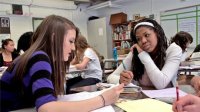Re-Imagining the Comprehensive High School
Sammamish High School is a comprehensive high school that is on the cutting edge of public education. Like many schools, we serve a diverse student body, with 45% of our students receiving free and reduced lunch support. We also serve a high percentage of special education students relative to other district schools, and currently house the district-wide program for beginning and intermediate English language learners. We have had good success with college matriculation rates, but as a community, we saw an opportunity to better serve our students and foster in them the skills and habits of mind that will make them competitive in the new economy. Along the way, we are challenging ourselves to re-imagine how school can better serve students through collaboration, authentic problem solving, and opening windows between the disciplines of school and the broader community.
In 2010, we applied for and received an Investing in Innovation (i3) grant from the Department of Education that allowed us to embark on an ambitious project to fundamentally shift the learning experience in our school. Two key aspects of that shift are PBL (Problem-Based Learning) curriculum and a focus on STEM (Science, Technology, Engineering and Math) literacy and skills. Our grant work thus far has reinvigorated our teachers through sustained professional learning, and provided our students with increasing opportunities to connect their work in the classroom with their passions in the world.
STEM and PBL
At Sammamish, STEM literacy includes but also goes beyond STEM content. We see STEM and PBL as being intertwined in their focus on pushing students to integrate and synthesize their learning across all disciplines. Processes of collaboration, critical thinking, design and revision inform instruction across the content areas, whether students are designing and curating original art exhibits or making pricing recommendations to the student store. A strong foundation in content knowledge and these deeper, cross-curricular skills prepare students for a variety of college and career experiences.
The Seven Key Elements
It is important for our school to design PBL in a way that would be authentic across disciplines, grades and courses. Instead of focusing on a format, we chose to identify and define these key elements of the fundamental shift in instruction:
- Authentic problems
- Authentic assessment
- Student voice
- Collaboration
- Use of expertise
- Culturally responsive instruction
- Academic discourse
Once we identified the elements, we defined them by accessing a wide range of literature around best practice. Next we built off the definition of each element to articulate what different levels of implementation could look like in classrooms, and we developed that into an implementation continuum. The continuum ranges from inclusion to empowerment, and what drives coursework up the scale is generally the amount of control students have over the learning experience in their classroom. We see powerful PBL that ranges from solving teacher-identified problems (inclusion) to solving problems brought in by members of the community (transformation) to students identifying a problem to solve (empowerment). The continuum serves as a tool for reflection both among teachers and between teachers and students. It also serves as inspiration for what is possible when the student is truly the driver of his or her own learning.
Professional Learning
A major use of i3 grant funding at Sammamish supports professional learning in multiple forms. PBL course re-design occurs in a phased way across the school, as course teachers receive a year-long, one-period release to collaboratively plan new PBL curriculum. This presents a real challenge, as we are not asking our teachers to redesign a unit at a time, but to examine their entire course and redesign elements of it to increase student ownership and creatively link their content to real disciplines and contemporary problems. Design teamwork gives teachers the time and collaborative space to think about putting something new and different in their classroom. It also allows teachers to learn from each other with a focus on the student experience and deepening their own reflective practice.
In addition to design teamwork, we bring our entire staff together in the summer for a five-day paid professional learning conference. We use this time to engage the staff in learning together around our seven key elements and applying them to practical classroom implementation. Teachers start by identifying the kinds of learning needed. They use research literature and partnerships with the University of Washington Institute for Science and Math Education, Washington STEM, the Educational Policy Improvement Center, and others to design workshops. Then they engage their colleagues in learning how to push current practice to new levels. While this training is optional for staff, more than 90% of our teachers typically participate. Over the course of two years, 50% of the staff have engaged in some kind of leadership role during the training.
At Sammamish, we strive to prepare students for the best possible futures in a rapidly changing world -- and we see students and staff learn and grow together in the process. This is the first of eight posts that will give more insight into the work at Sammamish. In the following posts, seven of our teachers who have transitioned to PBL instruction will be writing about how they have revitalized their classrooms with one of the key elements mentioned above. We invite you to visit our website to learn more about our program as a whole.
We also hope you'll share your thoughts and ideas on these topics in the comments section of this post:
- Have you tried implementing PBL in your school?
- How has it gone so far?
- What aspects of our experience would be of interest to you?
We will be producing more videos and blog posts, and would love your feedback as to what would be most helpful.
Editor’s Note: Visit “Case Study: Reinventing a Public High School with Problem-Based Learning” to stay updated on Edutopia’s coverage of Sammamish High School.
